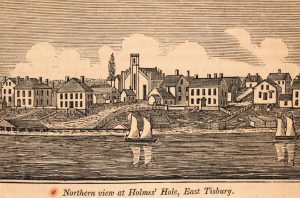 Recently, I traveled to Martha’s Vineyard to conduct some research at the Dukes County Registry of Deeds. There, as I was learning about property located in Tisbury, I came across some familiar folks – my great-great-great-grandparents! In another genealogical coincidence, I learned that the gentleman I was researching bought my great-great-great-grandparents’ home in Tisbury. Continue reading Frog Alley
Recently, I traveled to Martha’s Vineyard to conduct some research at the Dukes County Registry of Deeds. There, as I was learning about property located in Tisbury, I came across some familiar folks – my great-great-great-grandparents! In another genealogical coincidence, I learned that the gentleman I was researching bought my great-great-great-grandparents’ home in Tisbury. Continue reading Frog Alley
Tag Archives: Brick Walls
When everything changed
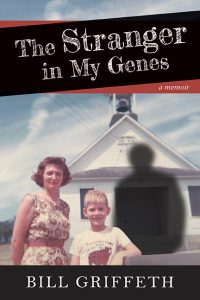 The rustic handmade sign above the door said “Ye ol’ Genealogical Research Center Library and Museum.” The letters were in Old English style. They were painted yellow over a green background, and they perfectly captured the upbeat, cheery nature of my friend Tom.
The rustic handmade sign above the door said “Ye ol’ Genealogical Research Center Library and Museum.” The letters were in Old English style. They were painted yellow over a green background, and they perfectly captured the upbeat, cheery nature of my friend Tom.
“Step in,” he urged me. I walked through the door and into his study. This was where he had spent the first fifteen years of his retirement researching his family’s history. Even before I entered the room, I knew what I would see, and I didn’t like it. Continue reading When everything changed
A Loyalist history lesson
 One of the delightful things about genealogy is that it often leads us to learn, and re-learn, our history lessons in unexpected ways.
One of the delightful things about genealogy is that it often leads us to learn, and re-learn, our history lessons in unexpected ways.
I have struggled for many years trying to find any New York documents on my immigrant ancestor John LeClear. He came from France probably at some point in the 1760s. I had first found him in the 1790 U.S. Census living in Half Moon, Albany County, New York. My only other clues came from copies of copies of some letters written by his then 93-year-old grandson, Shubael, which laid out the names and marriages of the first couple of generations of the family, mostly without places or dates. Shubael did state the John lived near Poughkeepsie before moving north to Albany. However, no church, cemetery, or vital records have emerged to help support this statement. Continue reading A Loyalist history lesson
Creative dating
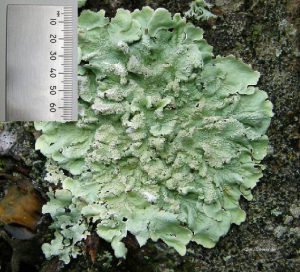 I think about genealogy for much of my day. Therefore, on a recent trip to Boston’s Museum of Science, I was again thinking about how I could apply something that I learned that day to make me a better genealogist. Thankfully, the Museum has a new(er) exhibit that is designed to teach participants how to use context clues to properly date an old schoolhouse. The exhibit points to evidence that helps users to identify when the schoolhouse closed – specifically, drawing their attention to portraits of U.S. Presidents surrounding the room, concluding with Richard Nixon. (The students in my group eventually determined that the school probably closed between 1969 and 1974.) As a student who studied Public History in graduate school, the exhibit is fantastic. A perfect blend of education, logic, and most importantly, fun… Continue reading Creative dating
I think about genealogy for much of my day. Therefore, on a recent trip to Boston’s Museum of Science, I was again thinking about how I could apply something that I learned that day to make me a better genealogist. Thankfully, the Museum has a new(er) exhibit that is designed to teach participants how to use context clues to properly date an old schoolhouse. The exhibit points to evidence that helps users to identify when the schoolhouse closed – specifically, drawing their attention to portraits of U.S. Presidents surrounding the room, concluding with Richard Nixon. (The students in my group eventually determined that the school probably closed between 1969 and 1974.) As a student who studied Public History in graduate school, the exhibit is fantastic. A perfect blend of education, logic, and most importantly, fun… Continue reading Creative dating
Your questions answered
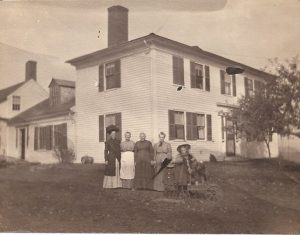
Sometimes we all, like Tennessee Williams, depend on the kindness of strangers – whether we realize it or not. While I’ve always shared my family research and stories, it has been only recently that I’ve come to understand how initiative, serendipity, and luck work together.
Four families – all my cousins – have lived in My Old House for the last 227 years, fine New England families who undoubtedly followed the old axiom “Use it up, wear it out, make it do, or do without.” Continue reading Your questions answered
ICYMI: Family papers
[Author’s note: This blog post originally appeared in Vita Brevis on 19 August 2015.]
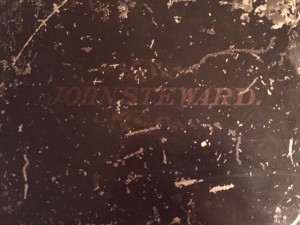 My grandfather died almost 25 years ago, and sometime before that he gave me a box of “family papers.” The box itself is rather striking: a metal strong box, easily portable, with my great-great-grandfather John Steward’s name stenciled on top in fading paint. Inside the box are not just family papers, but intriguing (and, of course, unidentified) daguerreotypes and examples of other early photographic processes, along with materials treating the family of my great-grandmother, Margaret Atherton (Beeckman) Steward (1861–1951). Continue reading ICYMI: Family papers
My grandfather died almost 25 years ago, and sometime before that he gave me a box of “family papers.” The box itself is rather striking: a metal strong box, easily portable, with my great-great-grandfather John Steward’s name stenciled on top in fading paint. Inside the box are not just family papers, but intriguing (and, of course, unidentified) daguerreotypes and examples of other early photographic processes, along with materials treating the family of my great-grandmother, Margaret Atherton (Beeckman) Steward (1861–1951). Continue reading ICYMI: Family papers
Lost generations

One of the trends in my ancestry is the curious one whereby, when given the choice between staying in a locale or moving on, my nineteenth-century forebears often remained behind as other relatives ventured further west. One of the sadder family stories is covered in the 1999 book Intimate Frontiers: Sex, Gender, and Culture in Old California, by Albert L. Hurtado, and concerns my great-great-great-uncle John Henry Beeckman (1818–1850).
Uncle John was the eldest son of Henry Beeckman and Catherine McPhaedris Livingston, and the family was a prosperous one in the days before the Civil War. That they were socially acceptable to New Yorkers and Virginians alike is suggested by the fact that John H. Beeckman married Margaret Gardiner in 1848 at the Virginia plantation of the bride’s brother-in-law, former President John Tyler. Still, John Beeckman was a young man, fired up by the discovery of gold in California, and in 1849 he left bride and newborn son to travel west. Continue reading Lost generations
The stranger in my genes
 When I was writing my new book, The Stranger in My Genes – about the DNA test I took that shockingly suggested my father wasn’t really my father – I thought my story was unusual, if not unique. Boy, was I wrong.
When I was writing my new book, The Stranger in My Genes – about the DNA test I took that shockingly suggested my father wasn’t really my father – I thought my story was unusual, if not unique. Boy, was I wrong.
After the ebook version was released on August 23, I almost immediately heard from several friends who told me about people they knew with similar stories.
There was the one about the man who received a DNA testing kit for Christmas one year, and – long story short – discovered a daughter he didn’t know he had. Merry Christmas. Continue reading The stranger in my genes
Memories of things unknown
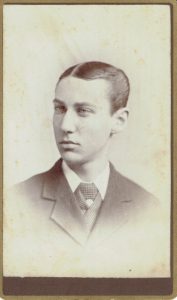
Many family history researchers are hard-pressed to find personal information, photographs, memorabilia, or heirlooms to treasure and preserve. I am not one of them, and yet I seem to have a remarkable supply of “memories of things unknown,” the scraps of someone’s attempt to memorialize a moment or a personality in a manner obvious to the author but obscure to later generations. I have stacks of unmarked photos of unnamed family members, locations, cattle, horses, barn cats, and especially Dalmatian dogs.
My great-grandfather Ambrose Church’s autograph book from his school days at the Oak Grove Seminary in Vassalboro, Maine – a girls’ school founded by the Society of Friends, but open as co-ed to local children – is a case in point. Continue reading Memories of things unknown
Honoring a Civil War veteran
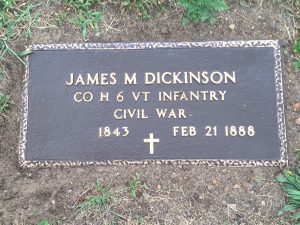 My great-great-great-grandfather, Elijah Dickinson, enlisted in Union Army in 1862. He was joined by both of his brothers, Atwood and James, as well as their sister’s husband, Nelson Cohaskey. The four of them served in Vermont’s 6th Infantry. Elijah died of disease during the war and is buried in Washington, D.C. Nelson also died while serving and is buried in Annapolis, Maryland. Atwood survived the war, moved from Vermont to Iowa, and is buried there. Continue reading Honoring a Civil War veteran
My great-great-great-grandfather, Elijah Dickinson, enlisted in Union Army in 1862. He was joined by both of his brothers, Atwood and James, as well as their sister’s husband, Nelson Cohaskey. The four of them served in Vermont’s 6th Infantry. Elijah died of disease during the war and is buried in Washington, D.C. Nelson also died while serving and is buried in Annapolis, Maryland. Atwood survived the war, moved from Vermont to Iowa, and is buried there. Continue reading Honoring a Civil War veteran